1908 Devrimi'nde Politik Tiyatro ve Besa Oyunu
Diğer birçok devrimde olduğu gibi 1908 Devrimi de bir tiyatro salgını yarattı. Romanlardan, gazetelerden, dergilerden ve risalelerden farklı olarak, okuma yazma oranının çok düşük olduğu dönemlerde ve toplumlarda tiyatronun kitlelere ulaşma noktasında önemli bir üstünlüğe sahiptir. Bu nedenle özellikle toplumun ileri gelenleri tiyatroya bir araç gözüyle bakmaya başlamışlardır. Siyasi fikirlerin, ideolojilerin topluma yayılmasına ve meşrulaştırılmasında tiyatro önemli işlevler edinmiştir. Tiyatro sadece edebi metinlerden oluşmaz, aynı zamanda politik ve toplumsal bir fenomendir. Kendisi bir kamusal mekan olan tiyatro, devrim zamanlarında meydanlar ve sokaklar gibi kamusal alanlarda ciddi toplumsal ve politik etkileri olan performanslar ortaya koyabilir. 1908 Devrimi de Besa, Vatan yahud Silistre ve Sabah-ı Hürriyet gibi devrimci oyunları gündeme getirdi. Besa oyunu devrimin ilk oyunuydu. Şemsettin Sami’nin bu yasaklı oyunun devrimin ilk günlerinde sahnelenmesi çok sembolik bir öneme haizdi. Besa’dan sonra tiyatro çok kısa bir sürede meydanlara ve sokağa inecekti.
Political Theatre in the 1908 Revolution and the Besa
The 1908 Revolution in the Ottoman Empire, like other revolutions such as French Revolution and 1917 Russian Revolution, was followed by a theater epidemic. Unlike novels, newspapers, journals and pamphlets, theater has the potential of reaching out to the illiterate masses. That is why, the elites made use of it for their causes. Theater was a political vehicle in disseminating and legitimating political ideals. Yet, the theater plays were not only literary texts but also social and political phenomenons. Their performances in public spaces had crucial social and political affects. The 1908 Revolution was accompanied by a genre of revolutionary plays such as “Besa,” “Vatan yahud Silistre” and “Sabah-ı Hürriyet.” This article focuses on the first performance of Besa after the promulgation of the second constitution. It was the first experience of revolutionary theater. It demonstrated the power of theater for mass mobilization as well as the need of the Committee of Union and Progress to control and contain it within its own ideological framework. The performance was regarded by many as the true marker of a new era. Besa was perfomed by theater groups such as Ahmet Fehim and Mınakyan which had existed in the pre-constitutional period. The performances of these groups demonstrate how the political context pushed these pre-existing theater groups to change their repertoires. Besa is the first example of revolutionary performances preaching Ottomanism to the masses.
___
- Gazeteler Sabah
- Tercüman-ı Hakikat
- Millet
- Servet-i Fünun
- İttifak
- Tanin
- İkincil Kaynaklar
- Ahmet Fehim Bey’in Hatıraları. Ed. Hafi Kadri Alpman. İstanbul: Kervan Matbaacılık, 1977.
- AND, Metin. Meşrutiyet Döneminde Türk Tiyatrosu (1908-1923). Ankara: Türkiye İş Bankası Kültür Yayınları, 1971.
- FRIEDLAND, Paul. Political Actors: Representative Bodies and Theatricality in the Age of the French Revolution. Ithaca: Cornell University Pres, 2002.
- MALLY, Lynn. Revolutionary Acts: Amateur Theater and the Soviet State 1917-1938. Ithaca: Cornell University Pres, 2000.
- RUDNITSKY, Konstantin. Russian and Soviet Theater 1905-1932. New York: Harry N. Abrams, 1988.
- SEÇKIN, Bilge. “Staging The Revolution: The Theatre of the Revolution in the Ottoman Empire 1908-1909,” Yayınlanmamış Yüksek Lisans Tezi, Boğaziçi Üniversitesi 2007.
- YALÇIN, Alemdar. II. Meşrutiyette Tiyatro Edebiyatı Tarihi. Ankara: Akçağ Yayınları, 2002.
- ISSN: 1303-1260
- Yayın Aralığı: Yılda 2 Sayı
- Yayıncı: İstanbul Üniversitesi
Sayıdaki Diğer Makaleler
1908 Devrimi'nde Kamusal Alan ve Kitle Siyasetinde Dönüşüm
Osmanlı'nın Son Döneminde İstanbul Sokaklarında Marjinaller: Hırsızlar, Dolandırıcılar, Yankesiciler
"Whats is the Meaning of the 1908 Young Turk Revolution? A Critical Historical Assessment in 2008"
II. Meşrutiyet'in İlanının İstanbul Basını'ndaki Yansımaları (1908)
İkinci Meşrutiyet ve Osmanlı İmparatorluğu'nda Alman-İngiliz Nüfuz Mücadelesi
II. Meşrutiyet'in Cumhuriyet'e Mirası: "Makbul Kadınlar"
1908 Devrimi'nde Politik Tiyatro ve Besa Oyunu
Meşrutiyet'te Kadın Eğitimine Yönelik Bir Girişim: İnas Darülfünunu
